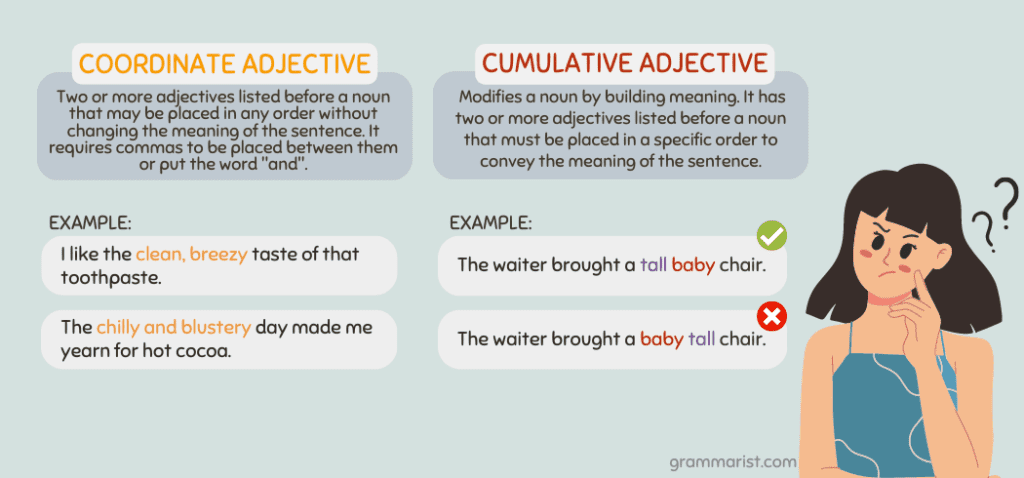To make your sentences interesting and concise, you should always include adjectives to help clarify your nouns and pronouns. There are two types of adjectives: coordinate and cumulative.
It’s important to know the difference between these types of adjectives, so you know how to punctuate and provide clarity to your sentences properly. Let’s review the rules of adjectives and practice with a worksheet.

What Is an Adjective?
Adjectives modify or describe a noun or pronoun. They provide detail and clarity to your sentences and help to quantify or provide quality to someone or something.
For example:
- The brown dog chased the bouncing red ball.
The adjectives in this sentence are brown, bouncing, and red.
What Is a Coordinate Adjective?
Coordinate adjectives are two or more adjectives listed before a noun that may be placed in any order without changing the meaning of the sentence.
For example:
- I like the clean, breezy taste of that toothpaste.
- I like the breezy, clean taste of that toothpaste.
Changing the order of the adjectives clean and breezy does not change the meaning of the sentence, so these are coordinate adjectives. Note that coordinate adjectives require commas to be placed between them.
It is also possible to put the word “and” between coordinate adjectives and still have a grammatically correct sentence.
- The chilly, blustery day made me yearn for hot cocoa.
- The chilly and blustery day made me yearn for hot cocoa.
What Is a Cumulative Adjective?
Cumulative adjectives modify a noun by building meaning. Cumulative adjectives are two or more adjectives listed before a noun that must be placed in a specific order to convey the meaning of the sentence.
- Correct: The waiter brought a tall baby chair.
- Incorrect: The waiter brought a baby tall chair.
In the example above, the first sentence contains cumulative adjectives. The word baby must be next to the noun it modifies, chair, to make sense. If the cumulative adjectives are reversed, the entire meaning of the sentence changes. Note that when using cumulative adjectives, no comma is used.
Let’s look at another example:
- Correct: The beautiful Dutch doors opened into the backyard.
- Incorrect: The Dutch beautiful doors opened into the backyard.
In the above sentence, a Dutch door is a particular type of door, and the adjective Dutch must appear immediately before the word door to convey the sentence’s intended meaning.
Choosing the order of cumulative adjectives can be confusing, but if you can remember the rules pertaining to the order of cumulation, you should always get it correct.
Number or Quantity
such as few, an or three
Opinion or Quality
such as beautiful or priceless
Size
such as gargantuan or petite
Age
such as young or aged
Shape
such as square or oblong
Color
such as red, pink, or white
Origin
such as Greek or Dutch
Material
such as wooden or plastic
Qualifier
The qualifier is an adjective that denotes the item’s type or purpose. Some examples are evening bag and cooking pot.
Let’s Review
Coordinate adjectives are two or more adjectives listed before a noun that may be placed in any order without changing the meaning of the sentence. They must be separated by a comma or the word and.
Cumulative adjectives modify a noun by building meaning. Cumulative adjectives are two or more adjectives listed before a noun that must be placed in a specific order to convey the meaning of the sentence.